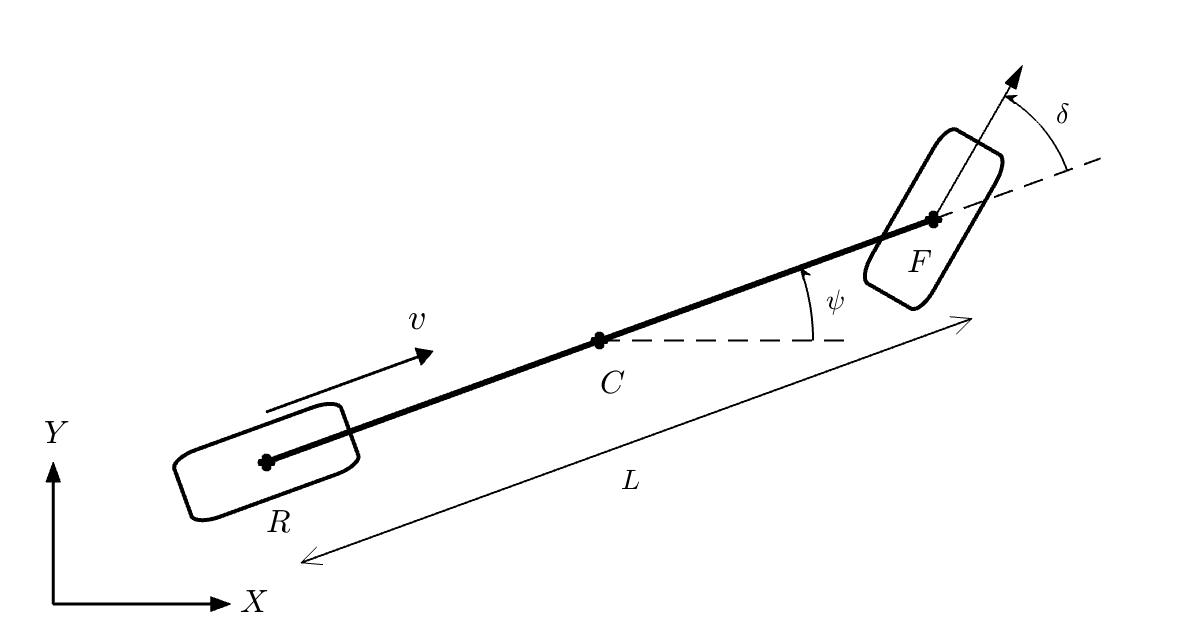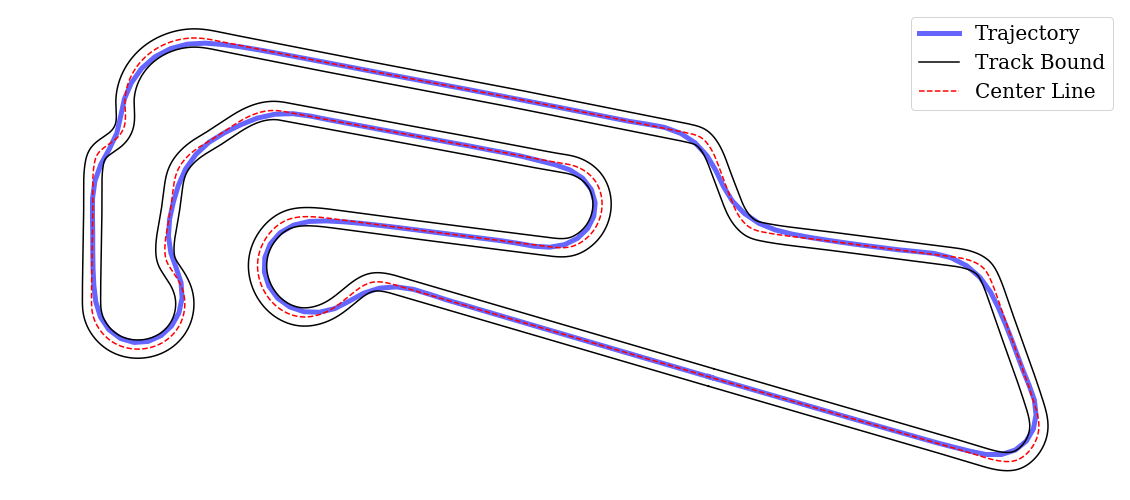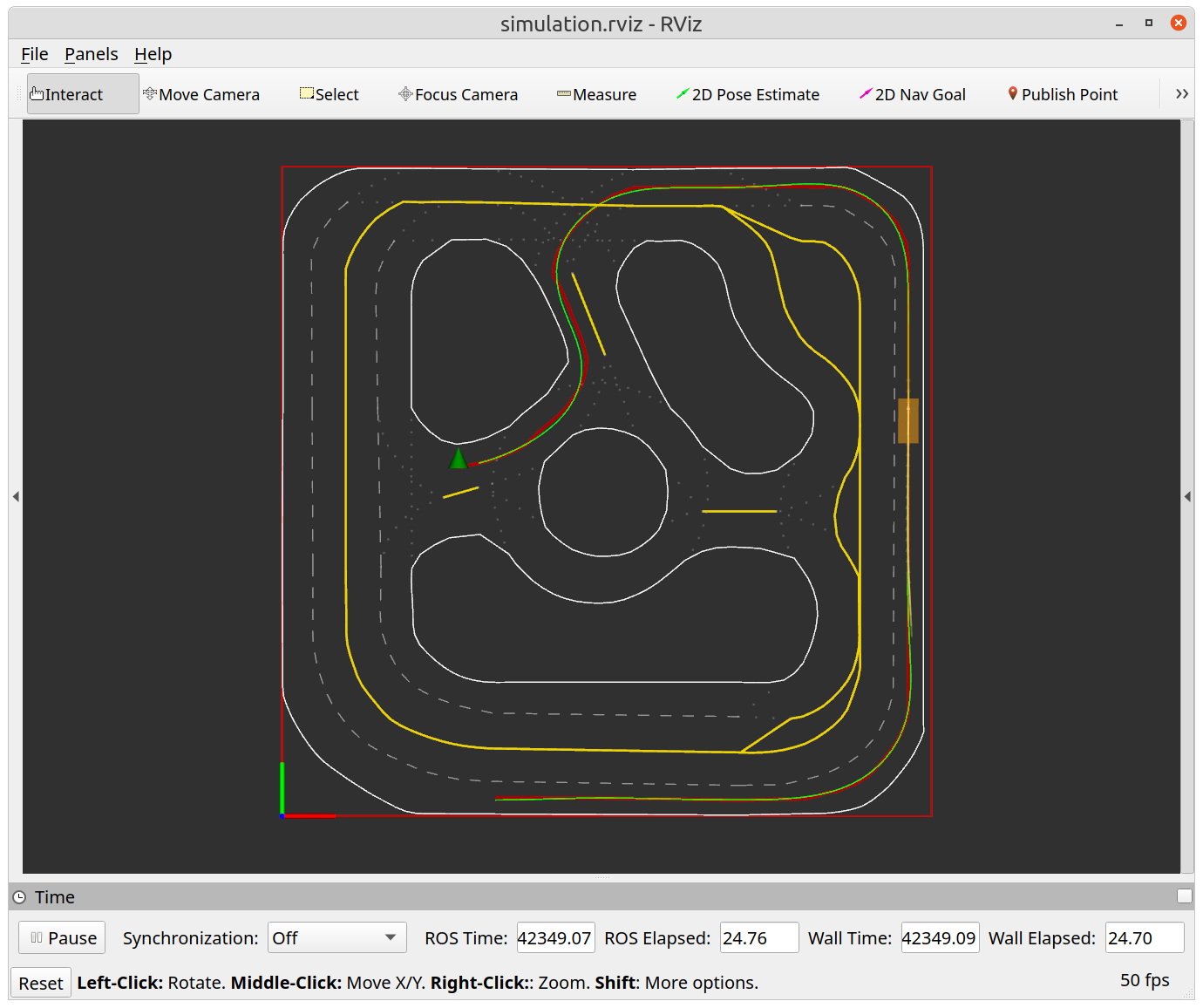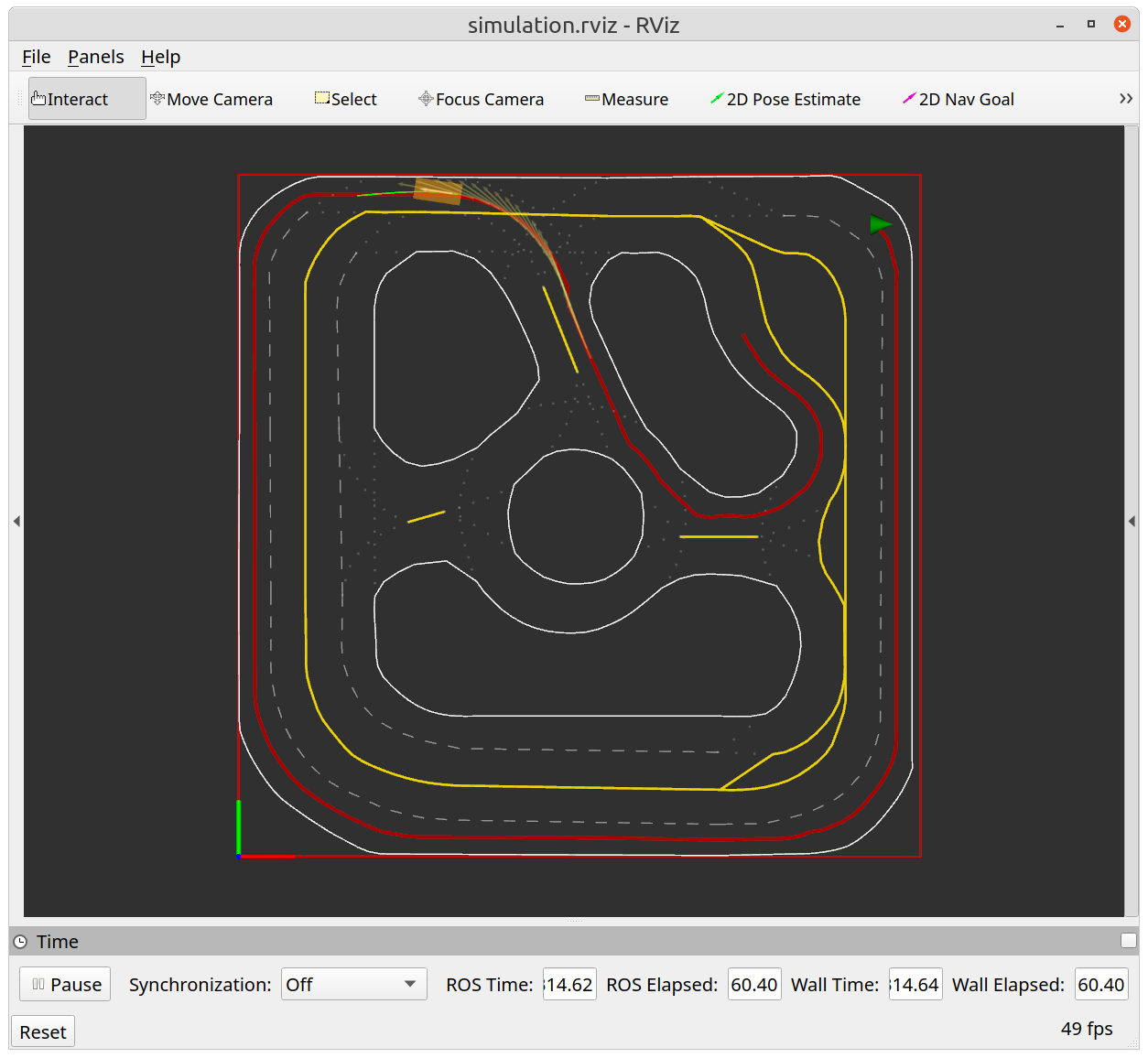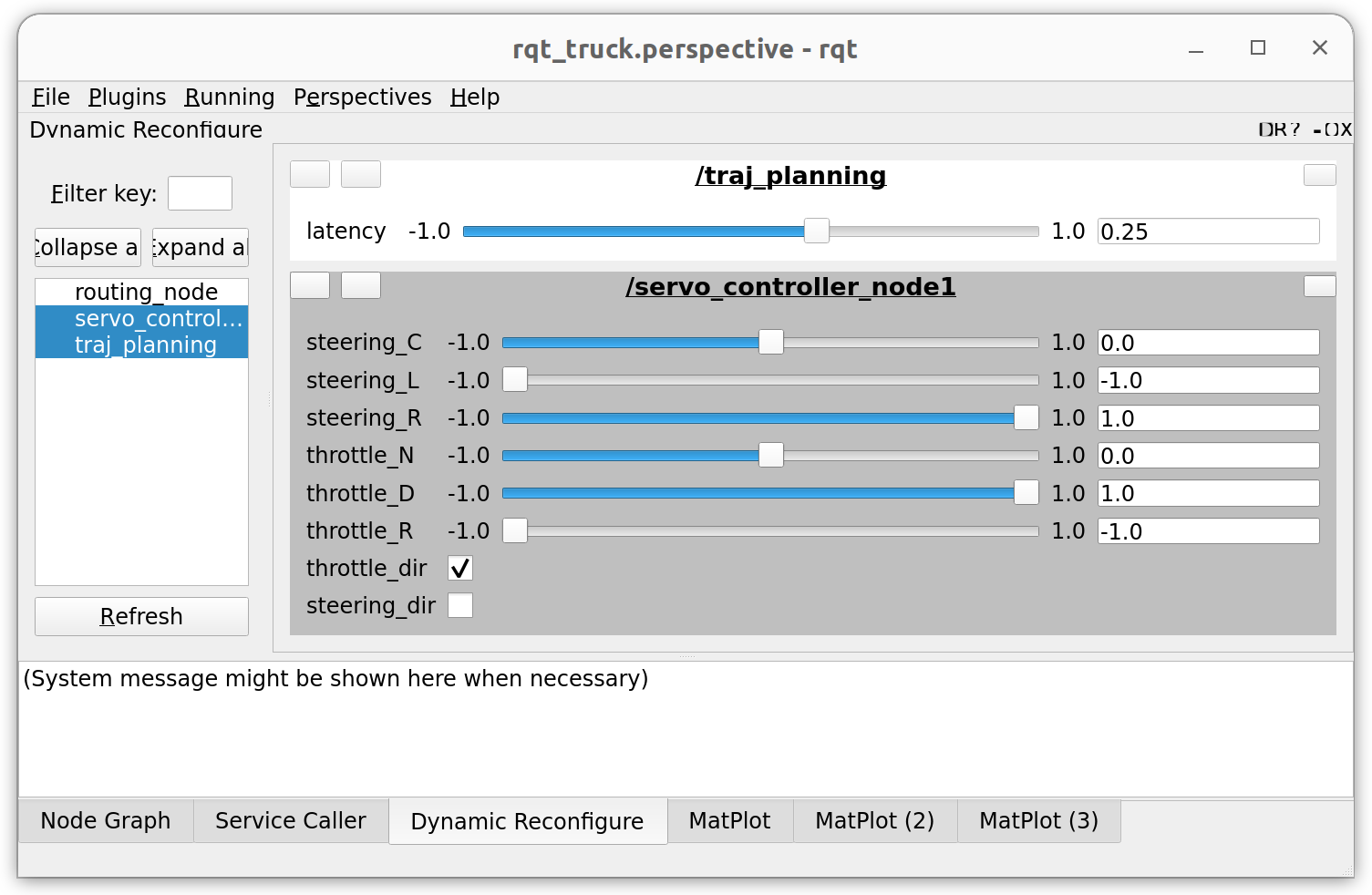[Due 11:59PM Thursday, February 27]
This lab will focus on the fundamental robot trajectory planning problem using optimization-based methods. We will first express the trajectory planning problem as an optimal control problem and look into vehicle models that govern our robot's equations of motion. Then, we will utilize the iterative linear quadratic regulator (ILQR) to generate locally optimal trajectories and policy. In addition, we will design a receding horizon trajectory planner using your ILQR and test them on the simulator and the real robot.
There are 4 tasks in this lab, and you will need to submit (push) your code and submit your video recordings + comment to Canvas before 11:59PM February 27, 2025.
Note: Make sure you have pulled the code from upstream into your repository and updated all submodules, i.e.,
git pull upstream 2025 --recurse-submodulesIf you encounter the ModuleNotFoundError, please install missing packages using mamba install <package_name> under the ros_base environment. For example, to fix ModuleNotFoundError: No module named sklearn, you can use mamba install scikit-learn.
In this lab, you will build a trajectory planner for our robot. Specifically, we will develop the racecar_planner ROS package under the directory ROS_Core/src/Labs/Lab2. The basic software structure can be found in Figure 1.
Figure 1: Software Structure for lab 2
We will implement the ILQR algorithm in the ILQR class and test it in the Jupyter Notebook task1.ipynb. Then, we will develop open-loop and receding horizon trajectory planning algorithms with ROS inside the TrajectoryPlanner class. We will compare their performances in simulation and on the real robot.
We can formulate a trajectory planning problem as a discrete-time optimal control problem with a finite horizon  where we want to find a desired control sequences
where we want to find a desired control sequences
Throughout this semester, we will use the kinematic bicycle model to describe the 2D motion of ground vehicles. As shown the Figure 2, instead of modeling all four wheels, we combine the front wheels as a single wheel at
Figure 2: Kinematic Bicycle Model.
We assume the entire robot is a point mass at $R=\begin{bmatrix} X&Y \end{bmatrix}$ position, and the heading angle of the robot is
Let us consider the state of robot $x = \begin{bmatrix}
X & Y & v & \psi & \delta
\end{bmatrix}^T$. Under the kinematic bicycle model, the system dynamics can be expressed as
$\begin{equation}
\begin{bmatrix}
\dot{X} \
\dot{Y} \
\dot{v}\
\dot{\psi} \
\dot{\delta}
% \dot{\delta}
\end{bmatrix} = \begin{bmatrix}
v\cos(\psi) \
v\sin(\psi) \
a\
\frac{v}{L}\tan(\delta)\
\omega
\end{bmatrix}
\end{equation}$
where the system has control $u = \begin{bmatrix}
a & \omega
\end{bmatrix}$ as
This kinematic bicycle dynamic has been implemented in the Bicycle5D class.
In addition, we provide you with very efficient implementations of trajectory rollout and derivative using Jax. Specifically, you will find integrate_forward_np and
get_jacobian_np useful for your ILQR. Please refer to their docstrings for instructions.
One way to solve the optimal control problem posed above is using ILQR, which will find locally optimal control sequences by minimizing the cost function. Typical costs for our robot include deviation from the reference trajectory and velocity, penalties for large control values and collision, etc. By combining various cost functions with different weights, you can generate characteristic behaviors using your ILQR algorithm. As the example given in Figure 3*, the ILQR finds a time-optimal trajectory in a racetrack, whose centerline and track boundary are provided.
Figure 3: Trajectory around Motorsport Arena Oschersleben generated by ILQR.
We have implemented a set of cost functions within the Cost class, whose parameters can be defined by your configuration file. The description of each cost function and its parameters can be found in the code. In addition, we provide you with very efficient implementation to obtain Jacobian and Hessian of the cost function using Jax. Specifically, you will find get_derivatives_np and get_traj_cost useful for your ILQR. Please refer to their docstrings for instructions.
In lab 2, cost parameters for all tasks are provided. You are certainly welcome but not required to fine-tune those parameters.
Unlike the tasks you had in lab 1, task 1 is very open-ended. You will need to complete the main ILQR loop in the plan function of ILQR class following pseudocodes provided in the ILQR handout.
The plan function takes in the initial state
We have provided helper functions to compute cost and system rollout, as well as their derivatives. Detailed information can be found in the comment block of plan function. Once finished, test your planner with provided Jupyter Notebook task1.ipynb and take a video of your visualization results to upload to Canvas. This is also a good point to check in with a lab TA during lab OH to make sure you're on the right track, but you can submit everything at the very end if you’re confident you know what you’re doing!
In task 1, your ILQR generated a reference trajectory $x_{0:T}={\hat{x}_0,\cdots,\hat{x}T}$ and reference control $u{0:T}={\hat{u}_0,\cdots,\hat{u}_T}$ to complete the time trial on a racetrack. In addition, ILQR provides a local state feedback control policy to track the reference trajectory at each time step. For example, if the current state of the robot is
We have implemented the function to attain polices to traverse along a reference path in the policy_planning_thread function of the TrajectoryPlanner class. In task 2, you are asked to compute the robot's control as described in the feedback control equation above by completing the compute_control function of the TrajectoryPlanner class.
After finishing task 2, you can test the ILQR within our simulated environment. Launch your ROS nodes using the following:
# Navigate to ROS_Core
cd ECE346/ROS_Core
# Start virtual environment
conda activate ros_base
# Optional: Build ROS packages (if new packages)
catkin_make
# Set up laptop environment
source devel/setup.bash
# Launch simulation nodes
roslaunch racecar_planner ilqr_simulation.launchAfter seeing ILQR warm up finished on your terminal, you can choose any point on the map using 2D Nav Goal on your RViz. In Figure 4, we show an exemplary open-loop trajectory planned by the ILQR, where the red line is the reference path from the route planner and the green line is ILQR planned trajectory. Record a video of your simulation results to upload to Canvas.
Figure 4a: Example of task 2 (Policy Planner) Results
Figure 4b: Example of task 3 (Receding Horizon Planner) Results
Instead of computing the entire plan to track the reference path, we can utilize ILQR in a receding horizon fashion. Every time when the ROS node receives a new pose, we call ILQR to generate a new plan over a short horizon and use planned policy to generate controls.
In this task, you will need to finish the receding_horizon_planning_thread function of the TrajectoryPlanner class. You may find comment blocks inside this function helpful for your implementation. Once finished, test your receding horizon planner by launching:
# Navigate to ROS_Core
cd ECE346/ROS_Core
# Start virtual environment
conda activate ros_base
# Optional: Build ROS packages (if new packages)
catkin_make
# Set up laptop environment
source devel/setup.bash
# Launch simulation nodes
roslaunch racecar_planner ilqr_simulation.launch receding_horizon:=trueAfter seeing ILQR warm up finished on your terminal, you can choose any point on the map, using 2D Nav Goal on your RViz, and verify your receding horizon planner. Think about the advantages and disadvantages of the policy planner in task 2 and the receding horizon planner in this task. Record a video of your simulation to upload on Canvas and write a few sentences (e.g., as a comment or attached document) with your thoughts in your final submission.
The modularity of ROS allows us to quickly deploy our algorithms from the simulated environment into the real robot with minimal changes to your code. As you did in lab 1, test your trajectory planner on the mini truck with the provided ilqr_truck.launch. You can use receding_horizon option to choose between policy planner and receding horizon planner.
Open a terminal, SSH into your mini truck, and run the start up script. This should take ~60-90 seconds.
ssh [email protected]
cd ~/StartUp
./start_ros.sh 192.168.1.2XXOpen a second terminal,
navigate to the ROS_Core, activate the conda ROS environment, source the set up environment script, source the network configuration script, and launch visualization nodes by running:
# Navigate to ROS_Core
cd ECE346/ROS_Core
# Start virtual environment
conda activate ros_base
# Optional: Build ROS packages (if new packages)
catkin_make
# Set up laptop environment
source devel/setup.bash
# Set up laptop ("client") network config
# Check with: "hostname -I" in case laptop ip has changed
source network_ros_client.sh <ROBOT_IP> <LAPTOP_IP>
# Launch visualization nodes
roslaunch racecar_interface visualization.launchNavigate to Service Caller, choose /SLAM/start_slam, and click call.
Open a third terminal, cd into your ECE346 ROS workspace, complete the typical ROS environment set up, and launch your nodes!
# Navigate to ROS_Core
cd ECE346/ROS_Core
# Start virtual environment
conda activate ros_base
# Optional: Build ROS packages (if new packages)
catkin_make
# Set up laptop environment
source devel/setup.bash
# Set up laptop ("client") network config
source network_ros_client.sh <ROBOT_IP> <LAPTOP_IP>
# Launch ROS nodes, enable/disable receding_horizon
roslaunch lab2 ilqr_truck.launch receding_horizon=falseFigure 5: Update dynamic reconfigure parameters using RQT
Due to hardware limitations, you might find it necessary to tune the direction and center point of the steering control, as well as the latency composition value to improve the performance of your plsanner on the robot. Instead of passing those values as ROS parameters, and setting them by re-launching, we can use ROS Dynamic Reconfigure to adjust them on the fly. Detailed tutorials on Dynamic Reconfigure can be found here. You can adjust those parameters using RQT as shown in Figure 5.
Finally, test your planner on the mini-truck robot and record a video of your demonstration to be uploaded on Canvas. You can also double-check your demo with a lab TA during lab OH before uploading!

